Amazing Facts About Wildlife
Rose petals for solar power
And yet again, nature shows the way to make the best use of sunlight, says S.Ananthanarayanan.
The solar cell takes in light energy to and turns it into electricity. Vegetation makes use of light energy too, but to drive chemical changes to build carbohydrates. While the solar cell is a recent entrant, plants have been in the business since ages
and have evolved to capture and use as much of the light that falls on them as possible.
Ruben Hünig, Adrian Mertens, Moritz Stephan, Alexander Schulz, Benjamin Richter, Michael Hetterich, Michael Powalla, Uli Lemmer, Alexander Colsmann, and Guillaume Gomard, from Karlsruhe Institute of Technology, in Karlsruhe, Germany and the Centre for
Solar Energy and Hydrogen Research, Stuttgart, report in the journal, Advanced Optical Materials, that they have been able to isolate and reproduce the surface structure of the petals of the garden rose to create a surface that helps solar cells reduce how
much light they lose to reflection, and hence a 13% increase in their efficiency.
The authors explain that an early instance of an anti-reflecting surface, which was studied, is that of the eye of the moth, which needs both to see in the dark as well as to stay out of sight of predators. The moth’s eye surface, or the cornea, is provided
with an array of protrusions, of the dimensions of the wavelength of light, which make for a great part of light falling on the surface to pass through, in place of being reflected and lost. While this feature of the moth is effective to admit more light
and also show no reflection, plant surfaces can go a step further, by also rearranging the light waves that they pass without so that the waves can be better used by the underlying light mechanism, the authors say.
Light, as we know, consists of a combination of electric and magnetic waves, each being the cause and also the effect of the other, as they pass through, vacuum, in space, or the air, or glass, or water, etc. We can imagine that passage of the waves,
particularly their speed, depends on how electric or magnetic fields behave in different media. And in the case of all media, the effect is that the speed of light is less than what it is in vacuum, and for most materials, less than what it is in air. This
is why a light beam bends when it enters glass or water, and it is thanks to this that we have cameras, telescopes and the magnifying glass.
Apart from affecting the speed and the direction of light, these properties of materials also affect how much of incident light would pass through or reflect off a surface. For all materials, hence, a part of the light that falls on a surface is not transmitted,
but is reflected. This is so for almost all the angles at which light strikes the surface, with more reflection when the angle is shallow. Some of the light is thus always lost to reflection by the normal cornea of the eye, the leaf surface, which needs light
to create sugars, and, what is vital now for industry, the surface of the photo cell. And hence the great interest and value in developing ‘anti-reflecting’ or AR surfaces, to capture all the light falls on them.
In taking up the study of AR capabilities in plants, the researchers first carried out a survey of different plant surfaces to see which one was the best. The result of the survey is shown in the graph in the top left in picture 1, which shows how the
proportion of reflection drops as we move from a plane glass sheet to the surface of different kinds of leaf or petal, and reflection is the least, about 8%, in the case of the rose petal.
As shown in the inset on the top right of the same picture, the surface of the rose petal has protrusions packed close together, some 19 microns high and 32 microns wide, or nearly a half wider than they are high.

The experimenters copied the micro-pattern of the petals’ surface onto a silicone polymer mould. The mould was then used to create the same pattern on the surface of a glass substrate, as in the lower half, picture 1, The reflection properties of this
surface were then compared with those of a similar glass sheet with a simple cover with no micro-pattern. As shown in the graph in picture 2, while the level of reflection is low and about equal when light fell directly on the surfaces, this changes as the
slant increases and, at glancing angles, the level of reflection is many times lower for the rose structure treated surface. The trials also showed that this was so over all colours of the spectrum, which makes the rose petal structure a very attractive template
for light collection.
The study of the micro-pattern on the surface of the moth cornea, published in the year 2006, includes a discussion of the reason why the micro-pattern reduces the extent of reflection. As stated earlier, the reflection of light waves from transparent
surfaces happens because of the difference of the speed of light in vacuum, or air, and the material whose surface it is. It is the steep change in the material properties, and hence the speed of light, when light moves from vacuum or air to other materials,
that brings about reflection rather than passage through the transparent material. This is where the microstructure comes in. As the structures are of the same dimensions as the wavelength of light, they are able to affect the speed of light, and as the waves
move from the peaks of the micro-protuberances to their base, they experience a gradual change of speed, in place of the sudden change when they strike a plane surface. For the same reason, the pattern on the rose petal, now transferred to the experimental
glass sheet, is able to ease the transition from air to glass and reduce the proportion of light that is reflected.
The study also showed that the rose petal structure, which behaved like an array of micro-lenses, had the effect of making light diverge within the underlying medium, a light focusing effect, which increased the extent of its path and the efficiency of
conversion in a solar cell. In trials that were carried out with organic solar cells, the experimenters report an efficiency rise of 13% when the rose petal structure was used. This was with light falling normally on the solar cell. At glancing angles, the
rise in efficiency was as high as 44%.
“While standard micro lens arrays show both AR and light trapping properties, the rose structure enhances these effects through auxiliary nanofoldings…” the authors of the paper say. Further, with natural structures, higher ‘width to height’ ratios are
possible, apart from the ease of fabrication by simple replication, they say. There is need to gain “further knowledge about the contribution of the nanofolding, in particular its impact on the broadening of the propagation angle distribution,” the authors
say.
[the writer can be contacted at response@simplescience.in]
More help for the solar cell
The moth, which forages at night, is an evolutionary predecessor of butterflies, which are colourful and active in daylight. Butterflies appear to have lost the light capturing feature of the moth cornea. But there is a species of butterfly that has a
feature that is useful in the application of solar cells.
As the butterflies need to conserve weight, they have lightweight wings and limited muscular resources. The muscles used to take to flight hence need to warm in the sun before they can be used. The White Pieris butterfly, however, is found to get started,
even on cloudy days, before other kinds of butterfly.
The reason is the angle at which it holds its wings, but mainly a nano-pattern that covers the surface of the wings. Striations with spacing of the order of the wavelength of light, ruled on a reflecting surface, can focus light. Each wavelength, however
focuses at a different angle, and this may not be useful to collect sunlight, which has many wavelengths. And a random pattern would not be of any use at all. But a ‘quasi-random’ pattern, which can be painstakingly generated on a computer, it is found, can
focus a range of wavelengths. Now, the White Pieris butterfly has evolved to have just this kind of pattern on its wings. The wings thus focus all the use useful wavelengths of sun’s warmth on to the Pieris’ muscles and it takes to flight before others can.
The pattern on the wings have been peeled off and used with solar cells, resulting in huge increase in output, and also with addition of very little weight.
Another development is that the patterns on Blu Ray discs, which are a complicated coding of text matter or images, also have a quasi random character. These have also been found good for focusing a range of wavelengths on to solar cells, with the advantage
that they can be mass-produced.
While these are methods of getting more light to fall on the solar cell, the Karlsruhe/Stuttgart-rose petal advance is to help the solar cell make the best of the light that does.
|
Amazing Facts About Wildlife
Seabirds track ocean winds
Tracking the flight of birds is found to be a good way to map winds on the surface of the sea, says S.Ananthanarayanan.
The weather cock and the “single swallow that does not a summer make” represent the role that our feathered friends have traditionally played in climate science. It should not, hence, come as a surprise that following birds which fly above the sea turns
out to be more accurate than satellites or anemometers to get a picture of low altitude winds over the oceans.
Yoshinari Yonehara,, Yusuke Goto, Ken Yoda, Yutaka Watanuki, Lindsay C. Young, Henri Weimerskirch,
Charles-André Bost, and Katsufumi Sato, from the Tokyo University, Universities of Nagoya and Hokkaido in Japan, in Honolulu and the Unversité de La Rochelle, in France, report in the Proceedings of the National Academy of Sciences (PNAS) that flight paths
of soaring seabirds can complement existing sea surface wind data by providing very fine grained and rapid information of wind velocities.
The traditional devices are the windsock, which was once a familiar sight at airports, which were called aerodromes, and then the more sophisticated anemometers. While the windsock only showed the direction of the wind, there were other devices to measure
its speed. The first was the cup anemometer, which was set spinning by the wind. The next was the vane anemometer, which was little windmill with a tail. The speed of the spin was converted to wind speed by a counter, or even a dial. And there is the hot wire
anemometer, where how much a hot wire cools in the wind is measured by the change in the electrical resistance of the wire.
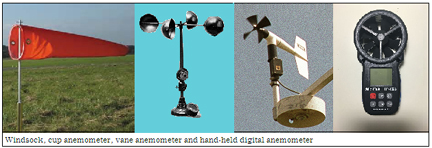
The weatherman also tracked the changes in wind speed and direction by sending up a hydrogen or helium balloon with a metal plate hanging from it. The plate served to show up in a radar screen and indicate the wind speed and direction at different altitudes,
as it rose up and up. Much more sophisticated is the laser Doppler anemometer, which depends on the change in frequency of laser light that is reflected by very small particles in the air. This is the method used to survey the wind distribution around a real,
power generation wind turbine.
The PNAS authors explain that these are really methods only to sample the wind speed at a few locations that are far apart and the sampling is often not continuous. For recording the wind behaviour on the surface of the sea, which is important to understand
the climate and also in coastal areas, the only means available was anemometers mounted on buoys that were distributed over a limited area being monitored.
The modern method, which is used to study winds over the surface of the sea, is with the help of satellites and a device called a scatterometer. In this method, pulses of microwaves, which are very short wavelength radio waves, are sent down to the earth
from a satellite, and the reflected pulses are detected. Winds create ripples on the surface of water, which can grow into large waves or swell, in the open ocean. While ripples are waves on the surface only, depending on the tendency of the surface not to
be pierced by the wind, the weight of the water being displaced also comes into play, and the resulting waves are in equilibrium with the wind. The pattern of such waves on the water leads to alternately lower or higher points of reflection and this leads
to mutual interference of the reflected radio waves, which can be related to the speed and direction of the wind. As the satellite goes round, it scans the entire earth and in conjunction with data from buoys stationed all over, which helps weather forecasts
and the study of ocean dynamics.
But the PNAS authors point out that a satellite observes each area only twice a day and the buoys are also far apart. The picture created is thus not fine grained and details of changes in winds could be missed. Another difficulty, they point out, is that
in coastal areas, where the wind and circulation features are significant, the topography affects the reliability of satellite data.
Animal borne data logging
The use of animals that carry miniaturized instrumentation has proved to be a way out in many challenging situations. “The extensive movement range and locomotion ability of marine mammals and seabirds enable observations to be obtained in places and scales
unresolved by conventional observations,” Yonehara and other say in the paper. “For example, instrumented seals have been providing temperature and salinity profiles in the Antarctic Ocean for more than 10 years, especially under sea ice coverage that was
difficult to measure by conventional methods,” they say.
Coming to wind data over the sea, the authors have studied how effective and useful the movement of soaring seabirds can be. Lightweight Global Positioning System (GPS) units were strapped onto the backs of three species, the streaked shearwater (0.6 kg),
the Laysan albatross (3.1 kg), and the wandering albatross (9.7 kg). Their flight path was then plotted by recording their position every second. We can see that this is sixty points for every minute of flight and would provide a fine grained picture of the
flight trajectory. As GPS visualizes the actual movement with respect to the ground, the speed of the wind that is affecting the birds’ flight would be extracted from changes in direction and speed.

The shearwater and the albatross are suitable because they carry out soaring flight which is largely wind dependent. The estimation of the wind speed is based on the fact that the ground speed is the highest with a tail wind and the least with a head wind,
and in between when the wind is in other directions. The various levels of ground speed, in different directions, over a span of soaring, would thus be distributed in an ‘up and down’ way, as is shown in the picture. And from the shape of the variation of
ground speed in terms of direction, the wind speed and the direction of the wind can be worked out.
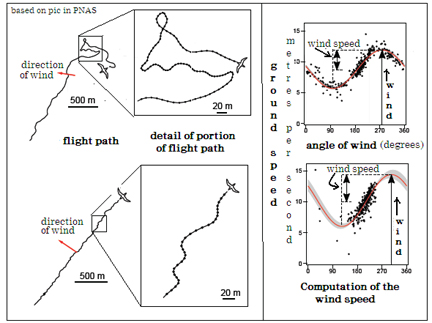
The paper details how the wind speeds derived from the bird sensors was verified with reliable instances of data from. The data had been collected at the Funakoshi–Ohshima Island breeding colony in Japan, Ka’ena Point, Oahu Island breeding colony in Hawaii
and at Possession Island, Crozet archipelago in the South Indian Ocean and the areas matched some of the ‘swathes’ covered by the satellite. In the area in the open sea, where the satellite gave good results, there was close agreement with the two sets of
results, the paper says.
While wind data from bird carried sensors could thus supplement that derived from the satellite and buoy mounted sensors, the paper says, and birds could be deployed to collect data in areas where satellite data is not possible, as near the coast. The
attaching of instruments to birds could also be a powerful instrument to study the wind environments that birds encounter during migratory flights, the paper says. Obtaining atmospheric and oceanographic data variables measured by seabird borne sensors is
a unique platform to study conditions far out at sea, “by using seabirds as a fast-moving, living ocean buoy,” the paper says.
[the writer can be contacted at response@simplescience.in]
|
Endangered
Sailana : The last hope for the Endangered Lesser Florican in Madhya Pradesh.
-Ajay Gadikar
The Lesser Florican (Sypheotides indicus) known as Kharmor or Likh is an endemic bird species found in the Indian subcontinent.
The Lesser Florican is also a threatened bird species and is classified as endangered (EN) in the Asian Red Data Book and protected under Schedule I of the Wildlife Protection Act (1972) of India. In Madhya Pradesh special protected areas are set aside
to conserve the Lesser Florican, like the Sardarpur Wildlife Sanctuary in the Dhar district and the Sailana Wildlife Sanctuary in Ratlam district.
It’s a bird of grasslands and visits at different areas of Western M.P. with the onset of southwest monsoon for breeding. Little is known about its whereabouts during the non-breeding period as the bird is usually spotted only during the breeding season.
It is best known for its aerial courtship display when the male makes a series of spectacular jumps to a height of 1.5 to 2 m. around 500 times in a day.
The Lesser Florican is omnivorous and eats invertebrates like grasshoppers, dung beetles, caterpillars, centipedes, worms and plant parts like crop shoots, leaves, herbs and berries.
The M.P. forest department with the help of Scientists from WII and BNHS is trying their best to conserve this bird habitat and save the bird from the clutches of extinction.
Lesser Florican displaying
Threats
1. The Lesser Florican is primarily threatened by hunting and poaching. Its population also get affected adversely by drought in its breeding areas.
2. Today a major threat to the Lesser Florican is uncontrolled cattle grazing in the grassland habitat between July to October which is also its breeding time. A large number of local livestock graze in the areas creating problem for the conservation of
habitat.
3. As insects and crop parts form a major part of the florican’s diet, excessive use of pesticides indirectly kills the bird it or affects its breeding.
4. The increase in the population of Bluebull in this area has always been a point of concern for the breeding females, many herds of bluebulls roam in this area which accidentally damages the eggs of lesser floricans.
5. Disturbance from unethical photography, because of revolution in digital photography and social media many people found engaged in unethical photography.
6. Illegal mining near the protected area of the sanctuary unsettles the bird coming to breed in the area.
7. Stray dog’s population has also increased considerably in all breeding areas of florican which also causes threat to this bird.
8. Inadequate knowledge of current distribution, population status, demography, movement-dispersal and habitat use.
9. New Wind Mill installation near the sanctuary areas is also causing an indirect threat to the bird.

Lesser florican habitat Conservation Initiatives
The initiatives taken by the forest department are to give prize money to any field farmer who spots a lesser florican in his fields and safeguard the bird. Also a compensation is provided to any farmer if a lesser florican lays eggs in his field.
Last year the forest department has started providing seeds of many indigenous crops free of cost to the farmers, so that the farmers in the area should divert from growing soya bean as the monsoon crop and shift to some indigenous crops cultivation.
Creation of a cattle camp near Sailana Sanctuary by the Forest Department, wherein more than 600 head of cattle were stall-fed, resulted in a decreased grazing pressure on the grassland habitat and also helped in a significant rejuvenation of vegetation
in florican habitat.
A large scale public movement was undertaken by the locals and NGO to save the sanctuary from the illegal mining and construction activities since last three years and legal case were filed in Green Tribunal court against the construction company.
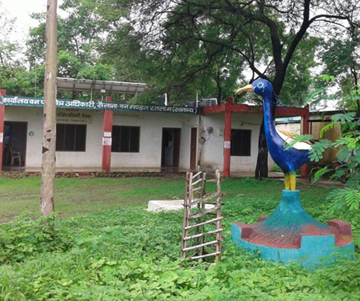
The forest office in Sailana
A new Conservation strategy: The use of organic farming.
Habitat degradation due to excessive use of chemical fertilizers and pesticides in agriculture owing to depleting soils is one of the major threats to the existence of Lesser floricans as well as other creatures existing on the grass land ecosystem. These
chemicals are killing a variety of insects and worms that constitute the food of the birds.
It is therefore necessary to educate, encourage and support local people to shift to organic farming, or the least minimize the use of chemical insecticides in preferred breeding grounds of floricans.
A lot of villages in the area have now taken up organic farming which is a good sign.
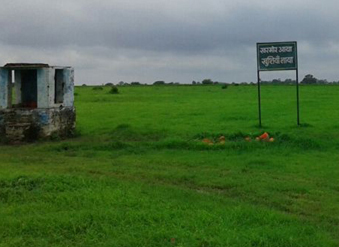
The lesser florican sanctuary Conclusion
The common and main reason for depleting number of lesser floricans can be summed up as the loss of their habitat, i.e. grasslands, grasslands getting converted to cultivated fields due to the ever increasing demand for food grains.
The change in the crops that’s being cultivated and the cultivation of Urad and other cereals replaced by cultivation of Soya beans over the years has also emerged as a grave threat for the floricans in all the areas.
Sailana Sanctuary in Ratlam district today still holds a very good chance to provide a safe and secure place for the visiting floricans in coming years. Floricans arriving here for breeding must be provided safe and secure environment to breed, as this
is a very important and among the last few breeding grounds left for this bird.
The Ratamba forest patch in the petlavad range of Jhabua has come up as a second ideal habitat for the endangered lesser florican in Madhya Pradesh. Lesser Floricans sightings are recorded here regularly here since last 5-6 years.
As the Sardarpur sanctuary has been devoid of lesser floricans since last three years this area should be given more weightage to ensure that the population of lesser floricans should not dwindle further in Madhya Pradesh.
(Text and photographs by Ajay Gadikar. Ajay Gadikar is an Ornithologist from Indore.)
|
Events
Upcoming events in August, 2016
A Walk in the Rain
Sunday, August 14 at 7 AM - 9:30 AM
at
Conservation Education Centre - ABWLS, Delhi
Asola Bhatti Wildlife Sanctuary, Near Karni Singh Shooting Range, New Delhi, India 110044
Tickets Available
www.cecdelhi.org
Details
Join on a walk through the forest of Asola on 14 August. Nature walk is the best way to make the most of the pleasant weather during the monsoon. Getting out in the wet world is a great way to experience the nature. Going on
a nature walk on a rainy day allows you to see many things you would not normally see. Birds and animals do different things in the rain as well. During your rainy day nature walk in Asola, try to find wild animals taking shelter from the rain. It is also
fun to photograph nature in the rain. Everything looks so lovely with drops of rain on it when photographed. In Asola, small rivulets and streams become active during the monsoon. Bring a waterproof camera and enjoy easy, guided walk in the Asola forest. Dress
the weather and don’t forget your water bottle.
Date: 14th August, Time: 7.00 a. m.-9.30 a. m.
Fees: Rs 500/ per head (The fees include refreshment)
For details contact: Education Officer on 011-26042010 or 8800741864, 9868441983
Email: cecbnhsdelhi@gmail.com, Last date for registration: 13th August 2016
Butterfly Walk
Sunday, August 21 at 7 AM - 9:30 AM
at
Conservation Education Centre - ABWLS, Delhi
Asola Bhatti Wildlife Sanctuary, Near Karni Singh Shooting Range, New Delhi, India 110044
Tickets Available
www.cecdelhi.org
Details
Join on a walk looking for butterflies in Asola Bhatti Wildlife Sanctuary. The sanctuary houses more than 90 species of butterflies. Some of the butterfly species found here are: Common Mormon, Common Emigrant, Mottled Emigrant, Red Pierrot, Common Pierrot,
Stripped Tiger, Plain Tiger and Blue Pansy etc. Watching butterflies is a delightful pursuit, as is bird watching and can be easily taken up while walking in the sunshine. Usually an hour after sunrise is the ideal time to watch these flying jewels. The best
time of the year for watching butterflies is from just after the rains to early November. During this season, host plants grow abundantly in Asola. Come and spend the morning exploring the forest and searching for as many different butterfly species as you
can find. Also, find out what particular tree or shrubs butterfly enjoy in Asola. You will also learn why butterflies are so important to the environment.
Date: 21st August, Time: 7.00 a.m.-9.30 a. m.
Fees: Rs 350/ per head
For details contact: Education Officer on 011-26042010 or 8800741864, 9868441983
Email: cecbnhsdelhi@gmail.com, Last date for registration: 20th August 2016.
The Mysterious World of Bats
August 26 organized by Delhi Birds
Friday, August 26 at 6 PM - 7:30 PM
at
WWF-India
172 B, Lodhi Estate, New Delhi, India 110003
Details
delhibird talk series presents Rohit Chakravarty:
Delhibirder Rohit Chakravarty is a wildlife researcher whose work focuses on bats. Having grown up in Nagpur his interested in wildlife was sparked in the most typical Central India way – with a tiger sighting. But his loyalty shifted to bats when he rescued
a fruit bat at the age of sixteen. He has worked on bats in the Western Ghats of Maharashtra, the Andaman and Nicobar Islands and more recently in the Himalayas of Uttarakhand. He is an alumnus of Wildlife Biology and Conservation at National Centre for Biological
Sciences, Bangalore.
Bats – amazingly diverse, extraordinarily adapted, truly enigmatic, but much maligned; this talk serves to introduce people to the ways of life of the most diverse group of mammals in our country, and why we they deserve more of our attention. The talk
is also about journey and adventure from vastly different regions of the country in the pursuit of bats.
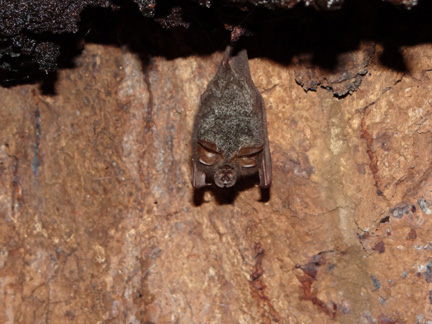
Horseshoe Bat in Periyar Wildlife Sanctuary Mothing at Phansad Wildlife Sanctuary
August 27 – August 28
Aug 27 at 6 AM to Aug 28 at 12 PM
Phansad Wildlife Sanctuary
Tembhode, Maharashtra 402202, Raigad, India 402202
Details
You might have visited Phansad earlier to study and photograph amphibians, reptiles and birds but imagine walking through the lush green forests and observing the tiny wonders of the insect world and studying moths under the dark night sky – an experience
that you would perhaps want to remember again and again. We will study moths on light trap, provided the clouds don't play spoil sport and learn how to do Moth Photography with Dr V Shubhalaxmi. Come join us and rediscover Phansad like you have never before
Venue: Phansad
Date: 27-28 August 2016
Time: 6.00 am (Day 1) - 12.00 pm (Day 2)
Meeting point: Dadar Chandu Halwai.
Group Leader: Dr. V.Shubhalaxmi, Founder & Managing Trustee INaturewatch Foundation
Study Theme: Moths, other insects and plant-insect associations
Group size: 15 persons
Camp Fee: Rs 4500/- per head (inclusive of accommodation, food, travel and resource person charges.)
Accommodation: Home Stay on multiple sharing basis in non AC rooms.
Things to carry:
Please carry notebook, pen, magnifying lens, torch light, rainy wear, mosquito repellent, proper rainy shoes, dry snacks, sufficient pairs of field clothes, water bottle, light warm clothes, sufficient spare clothes and personal medicines.
**Note that there is a strenuous walk involved. Please wear footwear that will help in strenuous walk. Wear full-sleeved shirts and full-length trousers.
REGISTRATION: Fill in the registration form available online at http://inaturewatch.org/registerforevent.php
Important Instructions
• This is a strenuous camp which involves walking
• The weather could be chilly., misty and rainy throughout
• Mobile connectivity may not be available
• Power outages are frequent so carry your mobile power hubs
• The camp is only possible if we get 15 participants or else the camp will be cancelled and the booking amount will be refunded..
Contact: at 9987013144 or email at info@inaturewatch.org
|
Forest and trees
CAMPA
"CAMPA Funds are like Blood Money"-J Krishnaswamy
-Usha Nair
The Compensatory Afforestation Fund Management and Planning Authority (CAMPA) Bill has been passed by both Houses of the Indian Parliament a few days back and is awaiting Presidential assent. The Bill is meant to promote afforestation and regeneration
activities as a way of compensating for forest land diverted to non-forest uses. Central Government while according prior approval under the Forest (Conservation) Act, 1980 for diversion of forest land for non-forest purpose stipulated conditions to the effect
that the State Government shall realize funds from the user agency for compensatory afforestation to mitigate impact of diversion of forest land. The Net Present Value (NPV) of the diverted forest is to be calculated for a period of 50 years, and recovered
from the “user agency” that is “diverting” the forests. CAMPA Bill provides for establishment of a permanent institutional framework at the Centre and at each State/UT to ensure utilization of these funds in an expeditious and transparent manner The Bill also
seeks to provide for constitution of a multi-disciplinary Monitoring Group to monitor activities undertaken from these funds, and also provides for annual audit of the accounts by the Comptroller& Auditor General.
On paper, India is taking all the right steps towards balancing its developmental objectives and fulfilling its international environmental commitments. The Indian government's recently presented Intended Nationally Determined Contribution to UNFCCC vows
to reduce the emissions intensity of its GDP by 33 to 35 percent by 2030 from 2005 level ,and create an additional carbon sink of 2.5 to 3 billion tonnes of CO2 equivalent through additional forest and tree cover by 2030.In March 2015,India consciously decided
for the first time ever, to include forest cover in tax allocation formula, by prescribing state government’s portion of tax revenue as partially dependent on how much forestland it has maintained. India has earmarked $6 billion, more than any other nation
in the world. The government is committed to enhance forest cover from 24 percent to 33 percent of the total geographical area.
It is a matter of satisfaction that United Nations Environment Programme (UNEP) in its Emission Gap Report 2014, has recognized India, as one of the countries, on course to achieving its voluntary goal of reducing the emissions intensity and lists India
as one of the few countries where forest and tree cover has increased in recent years from 23.4% in 2005 to 24% of the geographical area in 2013.India also has reported improving carbon stock in its forests by about 5%. Initiatives like Green India Mission
(GIM) and policies like National Agro-forestry Policy (NAP), REDD-Plus policy, Joint Forest Management; National Afforestation Programme all strive towards achieving the said objectives.
The latest fillip given to afforestation by the Indian Government is, however,a matter of worry for environmentalists, given that Compensatory afforestation predominantly consists of raising artificial plantations of non-native species of trees, with
zero biodiversity value. Even where plantations of mixed species of native trees have been raised, they do not come anywhere close to replicating the natural habitat that was destroyed. Commercial afforestation is a cause of major environmental degradation
and social problems. The drawbacks of afforestation have been detailed in several of my earlier articles on the subject. The net increase in forest cover does not indicate anything on the actual health of the natural grown forests. A high level committee
on environment laws had observed that the quality of forest cover has declined between 1951 and 2014, with poor quality of compensatory afforestation plantations being the key reason behind the situation.
N. H. Ravindranath opines that India could be potentially over-reporting the area under forests by including many non-forest tree categories such as commercial plantations of coconut, cashew, coffee and rubber, and fruit orchards. India may also be under-reporting
deforestation by reporting only gross forest area at the state and national levels. His analysis shows that the current mode of monitoring and reporting of forest area is inadequate to meet the national and international requirements. There is need to categorize
monitoring and reporting of forest cover, deforestation and afforestation rates under (i) natural/ primary forest, (ii) secondary/degraded forests, (iii) forest plantations, (iv) commercial plantations, (v) fruit orchards and (vi) scattered trees.
Souparna Lahiri observes that the annual loss of forests from diversion in India is estimated to be a staggering 35,000 ha and more. To claim that India is one of the lowest deforestation countries, as claimed in the INDC, is to hide the stark reality.
'India’s commitment to create an additional carbon sink of 2.5 to 3 billion tones of CO2 equivalent through additional forest and tree cover by 2030 is nothing but a veil to hide India’s continuing deforestation and privatization of India’s forests'.
The Centre for Science and Environment has termed the existing ad-hoc CAMPA regime as 'compromised compensation'. They have extensively quoted from the CAG Report titled ‘Compensatory Afforestation in India ( 2013)’ which listed many shortcomings .Thus,
Compensatory afforestation was carried out on only in 49 per cent of identified degraded forestlands. Seven states, carried out no compensatory afforestation. Numerous instances of unauthorized renewal of leases, illegal mining, continuance of mining leases
despite adverse comments in the monitoring reports, projects operating without environment clearances, unauthorized change of status of forestland and arbitrariness in decisions of forestry clearances were observed. In six states, encroachment of forestland
was noticed but no time-bound action was taken to evict encroachers, despite Supreme Court directions. Only 61% of the compensatory afforestation funds released by Ad hoc CAMPA from 2009-12 was utilized.
Gaurav Madan cites the Chinese model of compensatory afforestation where Communities manage forests more sustainably than governments or private entities. China has implemented one of Asia’s most successful forest reforms: more than 400 million people
have been given direct rights over approx.100m hectares. In India, the Indian Forest Rights Act(2006), empowers individual and community rights and if effectively implemented, at least 150 million people in 170,000 villages will exercise rights over 40m
hectares of forested land. This represents at least half of India’s forests. A concerted effort to implement the Act would usher in the largest land reform in India’s history. However, the CAMPA Bill is silent on the participation of Gram Sabhas and tribal
communities in the process of compensatory afforestation and does not give them any share in the funds. CAMPA funds may remain under the tight control of State Governments, and environmentalists doubt whether distantly seated bureaucracies can effectively
monitor the end use of CAMPA funds.
The INDIAN EXPRESS on 25/5/2016 commented on some of the difficulties on the ground."While the principle of compensatory afforestation, and the need for payment of NPV, is fairly straightforward, the implementation is plagued with complications. The
main difficulty has been the availability of non-forest land for afforestation. The law says the land selected should preferably be contiguous to the forest being diverted, so that it is easier for forest officials to manage it. But in case that is not possible,
land in any other part of the state can be used for the purpose. If no suitable non-forest land is found, degraded forests can be chosen for afforestation, but in that case, twice the area of diverted forest has to be afforested. Still, there is difficulty
in finding land, especially in smaller states, and in heavily forested ones like Chhattisgarh. The other point of contention has been the purposes for which the money can be used. The fund was envisaged to be used only for “compensatory” afforestation, but
the Bill before Parliament has expanded the list of works that this money can be utilised for, and includes the general afforestation programme run through the Green India Mission. Forest protection, forest management, forest and wildlife related infrastructure
development, wildlife conservation, facilitating relocation of people from protected wildlife areas, are proposed to be made valid expenditure from this account.' Critics say this will take the focus away from the prime objective of compensating for the forest
cover .
It is imperative that CAMPA funds are judiciously allocated and utilised towards sustainable forest growth. But are we likely to miss the woods for the trees?
(Usha Nair is a nature lover who can be contacted at ushaenvironment@gmail.com)
|
Gardening for wildlife
Bee- friendly gardens
20th August, World Honey Bee Day, was just another day for us Indians, we hardly cared. World Honey Bee Day, is an idea put together by beekeepers in the USA, who petitioned the USDA in 2009 for an official day to honour honey bees and beekeeping. A few years
down the line, people across the globe are holding a date of observation every year on August 20th. The observation of World Honey Bee Day signifies the growing awareness of the challenges brought about by declining bee populations across the world. Bees
are of great importance in sustaining bio diversity and food security.
Honey Bee on Bottle gourd flower
A honey bee is primarily distinguished by the production and storage of honey and the construction of perennial, colonial nests from wax. Solitary bees are important pollinators, and pollen is gathered for provisioning the nest with food for their brood.
Often it is mixed with nectar to form a paste-like consistency. Some solitary bees have very advanced types of pollen-carrying structures on their bodies. A very few species of solitary bees are being increasingly cultured for commercial pollination.
In June 2015, President Obama of the USA, issued a Presidential Memorandum directing an interagency Task Force to create a Strategy to Promote the Health of Honey Bees and Other Pollinators.
According to the 2015 White House (USA)notification announcing steps to promote pollinator health,
"Pollinators are critical to the Nation’s economy, food security, and environmental health. Honey bee pollination alone adds more than $15 billion in value to agricultural crops each year, and helps ensure that our diets include ample fruits, nuts, and
vegetables. This tremendously valuable service is provided to society by honey bees, native bees and other insect pollinators, birds, and bats.
But pollinators are struggling. Last year, beekeepers reported losing about 40% of honey bee colonies, threatening the viability of their livelihoods and the essential pollination services their bees provide to agriculture. Monarch butterflies, too, are
in jeopardy. The number of overwintering Monarchs in Mexico’s forests has declined by 90% or more over the past two decades, placing the iconic annual North American Monarch migration at risk.
The President has emphasized the need for an “all hands on deck” approach to promoting pollinator health, including engagement of citizens and communities and the forging of public-private partnerships. To foster collaboration, the interagency Pollinator
Health Task Force will work toward developing a Partnership Action Plan that guides coordination with the many state, local, industry, and citizen groups with interests in and capacities to help tackle the challenge facing pollinators.
People of all ages and communities across the country can play a role in responding to the President’s call to action. YOU can share some land with pollinators—bees, butterflies, other insects, birds, bats—by planting a pollinator garden or setting aside
some natural habitat. YOU can think carefully before applying any pesticides and always follow the label instructions. YOU can find out more about the pollinator species that live near you."
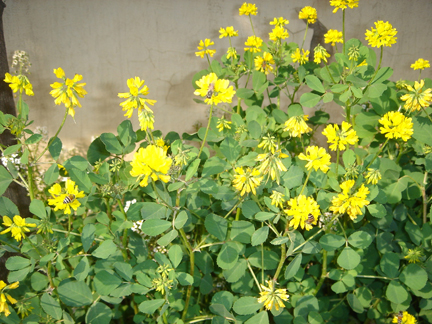
Honey bees on 'Methi' flowers
In India, our gardens can support many different objectives. They can support healthy lives for nature’s pollinators, primarily bees and butterflies. The development of fruits and vegetables, which are essentially seed cases, often depends on bees, and
butterflies are important pollinators of wild and cultivated flowers.
Our pollinators are threatened by civilization, notably habitat loss and agricultural chemicals. A pollinator-friendly garden has direct benefits for the bees and butterflies, and serves the gardener with the pleasure of beautiful surroundings and the
satisfaction of ecologically sound practices. Also, an enjoyable and educational counterpart to bird-watching is the emerging activity of bee-watching. There is much to learn from the bees!
Here are the names of some plants and their pollinators
Plant name Pollinators
Okra (Bhindi) Honey bees, Solitary Bees
Onion Honey bees, Solitary Bees
Mustard Honey bees, Solitary Bees
Coriander Honey bees, Solitary Bees
Broccoli Honey bees, Solitary Bees
Cauliflower Honey bees, Solitary Bees
Cabbage Honey bees, Solitary Bees
Carrot Honey bees, Solitary Bees, Flies
Eggplant Bumblebees, Honey bees
Tomato Bumblebees, Solitary bees
Chillies Honey bees, Solitary Bees, Hover flies, stingless bees
Papaya Honey bees, Moths, Butterflies
Lemon Honey bees
Lime Honey bees
Mango Honey bees, Stingless bees, Flies, Ants, Wasps
Guava Honey bees, Stingless bees, Solitary Bees, Bumble bees
Pomegranate Honey bees, Solitary Bees, Beetles
BottleGourd Honey bees, Solitary Bees, Beetles
|